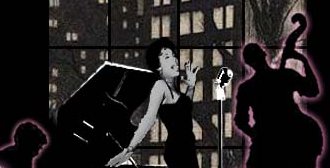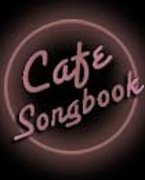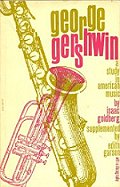Welcome toCafe SongbookInternet Home of the |
 |
 |
| Home || Songs || Songwriters || Performers || Articles and Blogs || Glossary || About Cafe Songbook || Contact/Submit Comment | |
| Search Tips: 1) Click "Find on This Page" button to activate page search box. 2) When searching for a name (e.g. a songwriter), enter last name only. 3) When searching for a song title on the catalog page, omit an initial "The" or "A". 4) more search tips. | |
| Portions of this page have not yet been completed. Thank you for your patience. | |||
Strike Up the Band |
|||
Written: 1927, 1929 |
Music by: George Gershwin |
Words by: Ira Gershwin |
Written for: Strike Up the Band |
| Page Menu | |||
| Main Stage || Record/Video Cabinet || Reading Room || Posted Comments || Credits | |||
On the Main Stage at Cafe Songbook |
||||
Two Performances of "Strike Up the Band" |
||||
Mickey Rooney, Judy Garland,
|
||||
| Amazon |
Barney Kessel and Tal Farlow
performing
"Strike Up the Band" (1988)
with Joe Byrd, Bass and Chuck Redd, drums
at ZDF Jazz Club, Leonberg, Germany, 1988.
As far
as we know, this duet has not been recorded. Click the links below for individual recordings of the song by Kessel (iTunes) and Farlow (Amazon).
| Amazon | iTunes |
video before starting another.)
Cafe Songbook Reading Room"Strike Up the Band" |
||||
| About the Show Strike Up the Band / Origins of the Song | ||||
|
Howard Pollack George Gershwin: His Life and Work
|
According to George Gershwin biographer Howard Pollack (pp. 396-397), the idea for the show Strike Up the Band came about when producer Edgar Selwyn heard, in 1926, that George S. Kaufman was at work on an anti-war satire and wanted the Gershwins to put it to music: "'We can all be grateful to Edgar Selwyn,' remarked Morrie Ryskind, for having the foresight to match their [The Gershwins'] genius with that of George Kaufman's.' The Gershwins were delighted at the prospect of working with Kaufman whom they considered 'the funniest and most intelligent playwright in America'." And, as it turned out, Ryskind, himself an anti-war type during his younger years, wound up rewriting Kaufman's bookafter the 1927 production failed even to make it as far as Broadway, closing in Philadelphia after only two weeks. Gershwin biographer Edward Jablonski recounts the Philadelphia experience when he writes that "the failure [of the run in Philadelphia] "is generally attributed to the bite of Kaufman's unmusical-comedy-like book.":
It was the rewrite by Ryskind that finally became a hit in 1930, and without it there would be a good chance we would know little about the show Strike Up the Band. As for the song "Strike Up the Band," Ira Gershwin wrote in his memoir Lyrics on Several Occasions that the final (or fifth) version of the music for the song "Strike Up the Band" was written by his brother George lying in bed during the middle of the night. It was the spring of 1927 and the brothers were in Atlantic City for a meeting with Edgar Selwyn, the producer of their show in progress, also titled Strike Up the Band. Ira had gone out to get the Sunday paper and upon returning to their adjoining rooms and seeing no light under the door assumed George was asleep; however, the door opened and the pajama clad composer informed his lyricist brother that he'd got it. When Ira pressed him to explain the "it," he replied, "Why the march of course, I think I've finally got it. Come on in." Apparently George had thought he'd gotten it on four previous occasions but this time he assured Ira this was it, even though the first four were written while he was at the piano, this one in his head while he was in bed. George sat down at the piano (He always had a piano in his hotel room.) and played it almost exactly as the song is now known. Ira pressed his brother that this would indeed be "it," that there would be no more "maybe I'll come up with something better[s]." The fifth try did, in fact, turn out to be "it." Ira went ahead and "wrote it up" (Lyrics on Several Occasions, pp. 224-227, paperback Ed.) The script, the lyric for the song and the show itself seemed to have been destined for endless revision: As Walter Rimler explains in his Gershwin Companion, and as referred to above, Gershwin had come up with four other melodies before settling on the one we all know and Ira kept revising his lyric to suit the mood of a rapidly and chaotically changing world:
Perhaps the revisions that have had the most lasting effect on the song are those put in place over succeeding decades by recordings and live performances by jazz musicians. It is not news that the richest source of material for jazz musicians, outside of their own compositions, has been The Songbook, but "Strike up the Band" is one of the few marches that has provided such inspiration. Howard Pollack suggests it was the song's ironic humor that explains this, noting that performances by such jazz greats as Charlie Parker (1950) and Oscar Peterson (1952) best capture this quality. Certainly the number of jazz performances of this "patriotic" march featured on this page would seem to confirm this. (See the Performer/Recording Index in the Cafe Songbook Record/Video Cabinet, right hand column, this page.)
|
|||
| back to top of page | ||||
| Critics Corner | ||||
|
In her 1958 supplement to Issac Goldberg's 1931 lifetime biography of his friend George Gershwin, Edith Garson notes that the 1927 production of Strike up the Band (although it failed even to reach Broadway until it was later revised in 1930) was the first of three "political operettas" with scores by the Gershwins. Strike up the Band lampooned war. (In that same year of 1927, Jerome Kern and Oscar Hammerstein had a much greater success with a seriously themed musical, Show Boat.) The other two Gershwin productions were Of Thee I Sing (1931) which won the Pulitzer Prize for its satire of American politics, and Let Them Eat Cake (1933), which took as its subject, revolution. Garson writes of the Gershwin trilogy of topical operettas:
|
|||
|
For Walter Rimler, Strike Up the Band was clearly a show in the spirit of Gilbert and Sullivan, the British operetta writers of the last half of the 19th century.
|
|||
To listen to the satirical 1927 verse, play the video at the 1990 Studio Cast recording in the Record/Video Cabinet which recreates the original 1927 production.
|
It was producer Edgar Selwyn, who was as devoted to Gilbert and Sullivan as antecedent and model as were the Gershwins, who pushed to make sure the influence of the British team remained strong in the revised versions of Strike Up the Band. Ira's satirical lyric for the verseof the title song "mocked jingoism":
Philip Furia points out, however, that Ira's lyric, when it got to George's stirring chorus, "got caught up in the very martial fever" the song was meant to mock:
Furia explains, "George had managed to cram a Sousa-like march into the confines ofTin Pan Alley's thirty-two bar AABA structure, and Ira gave in completely to the music's spirit creating an inspiring yet thoroughly vernacular, call to arms":
The patriotic power of the melody wedded to the no longer satirical lyric is probably more responsible for the continued success of the song and its being taken up by performers and movie producers like Mickey Rooney and Judy Garland in the MGM World War II Era movie that bears the title of the song and the earlier anti-war stage show, but otherwise reveals no relation to the original. (View the Rooney/Garland version above on the Cafe Songbook Main Stage.) (See Furia pp. 85-86 (hardcover Ed.). No doubt it is also George's stirring melody that resulted in the request in 1936 by The University of California at Los Angeles for Ira to compose a new lyric that would enable the University to use the piece as its fight song, which indeed it did.
and
|
|||
| back to top of page | ||||
| Lyrics Lounge | ||||
To read the lyric for "Strike Up the Band," at least for the chorus without the verse, click here. To hear the original verse left off of most recordings of the song because they would have been satires of war and patriotism during periods when such fare was no longer in vogue. To listen to the original satirical verse, go to the Record/Video Cabinet (this page), and play the video associated with the 1990 Studio Cast album, which recreates the original 1927 production of the show Strike Up the Band. See also excerpts from Philip Furia's discussion in the Critics Corner in which he comments on the changes in the song's lyrics during different time periods. (this page, above). Click here to read Cafe Songbook lyrics policy. |
||||
| back to top of page | ||||
Visitor CommentsSubmit comments on songs, songwriters, performers, etc.
Feel free to suggest an addition or correction. Please read our Comments Guidelines before making a submission. (Posting of comments is subject to the guidelines. Not all comments will be posted.) |
| To submit a comment, click here. |
Posted Comments on "Strike Up the Band":
Katestew (5/18/2016 11:58:39):You seem to have left off on your page, this song was used in the musical My One and Only also. The arrangement is quite nice too. |
| back to top of page |
Credits("Strike Up the Band" page) |
Credits for Videomakers of videos used on this page:
Borrowed material (text): The sources of all quoted and paraphrased text are cited. Such content is used under the rules of fair use to further the educational objectives of CafeSongbook.com. CafeSongbook.com makes no claims to rights of any kind in this content or the sources from which it comes.
Borrowed material (images): Images of CD, DVD, book and similar product covers are used courtesy of either Amazon.com
Any other images that appear on CafeSongbook.com pages are either in the public domain or appear through the specific permission of their owners. Such permission will be acknowledged in this space on the page where the image is used.
For further information on Cafe Songbook policies with regard to the above matters, see our "About Cafe Songbook" page (link at top and bottom of every page). |
The Cafe Songbook |
||||
|
Performer/Recording Index
(*indicates accompanying music-video)
|
||||
1929 Notes: Aside from "Rhapsody in Blue," "Strike Up the Band" and "That Certain Feeling," most of the tracks on the album have Gershwin playing some of his lesser known songs such as "I'm A Lonesome Little Raindrop," and "Left All Alone Again Blues." |
||||
1930 View/listen to music-video of Arden and Ohman and their orchestra on a Victor recording --center column, just below. |
||||
1950
Notes: Bird is backed here by what is sometimes referred to as his Swedish All Stars. "Tracks 1-4 were recorded at Amiralen Dance Hall in Malmo, Sweden on November 22, 1950. The ensemble backing Bird was comprised of Bird backed by Rolf Ericson on trumpet, Gosta Theselius on piano, Thore Jederby on bass and Jack Noren on drums. |
||||
| back to top of page | ||||
1952
Notes: "In what was a giant undertaking (even for producer Norman Granz), pianist Oscar Peterson recorded ten Songbook albums during 1952-1954 and when his trio changed, nine more in 1959. Both of his George Gershwin projects (one from 1952 and the other from 1959) have been reissued in full on this single CD. The earlier date matches the brilliant Peterson with guitarist Barney Kessel and bassist Ray Brown [and includes the "Strike Up the Band" Track], while the 1959 session has Brown and drummer Ed Thigpen. The Songbook series found Peterson playing concise (around three-minute) versions of tunes, and he always kept the melody in the forefront. The results are not innovative or unique, but they are tasteful and reasonably enjoyable. Since five of the songs are played by both groups, a comparison between the two units is interesting." Scott Yanow at CD Universe |
||||
| back to top of page | ||||
1957 (studio) 1959 (live)
Notes: Aside from the above studio recording, there is also a live performance by Connor of "Strike Up the Band" at the Village Vanguard" in New York, 1959, backed by the Bobby Timmons Trio with Kenny Burrell sitting in (originally on an Atlantic release Chris Connor in Person Live at the Village Vanguard). The live performance is available as a bonus track on the album referenced above as well as on the original Atlantic release:
(Please complete or pause one |
||||
1959
Notes: Originally recorded for the 1959 album Ella Fitzgerald Sings The George And Ira Gershwin Song Book |
||||
1959
Notes: "One of the best combinations in the history of jazz, presented here is superstar vocalist Tony Bennett performing with the amazing Count Basie Big Band. This historic album was recorded in 1959 and features a beautiful set of jazz standards performed with style and panache by Mr. Bennett, aided and abetted by one of the greatest bands in the history of jazz. The all-star lineup includes Tony Bennett (vocals); Count Basie (piano); Ralph Sharon (piano); Thad Jones (trumpet); Snookey Young (trumpet); Wendell Culley (trumpet); Joe Newman (trumpet); Charlie Fowlkes (baritone saxophone); Frank Foster (tenor saxophone); Billy Mitchell (tenor saxophone); Frank Wess (alto saxophone); Marshall Royal (alto saxophone); Benny Powell (trombone); Henry Coker (trombone); Al Grey (trombone); Freddie Green (guitar); Eddie Jones (bass) and Sonny Payne (drums). All selections newly remastered." (From Amazon |
||||
| back to top of page | ||||
1979
Notes: "Ira Gershwin himself approved of this record. Rosemary Clooney sings ten of his classic sets of lyrics, including eight songs written in collaboration with his brother George; the exceptions are 'Long Ago and Far Away' (music by Jerome Kern) and 'The Man That Got Away' (a later Harold Arlen song). Although not an improviser herself, Clooney excels in this swinging setting and includes occasional solos by cornetist Warren Vache, tenor saxophonist Scott Hamilton, flutist Roger Glenn, pianist Nat Pierce, and guitarist Cal Collins. All of Clooney's Concord albums are well worth acquiring." Scott Yanow / CD Universe |
||||
| back to top of page | ||||
c. 1980
Notes: Great collection of the Basie band swinging standards from 1975-1983 produced by Norman Granz for Pablo Records. |
||||
| back to top of page | ||||
1990
Notes: This recording is a 1990 studio recreation of the original 1927 score. It contains a version of "Strike up the Band" that incudes Ira Gershwin's original satirical
verse. (Listen on video just above.). (The explanatory text below is excerpted from an Amazon review of the recording by Gary F. Taylor: |
||||
2003
Notes: Recorded in Stuttgart, Germany, May 2003, released 2005. Born in Pittsburgh in 1924, Sammy Nestico is best known as a composer and arranger for Count Basie but has a career long history of doing big band arrangements for everyone from Frank Sinatra to the U.S. Marine and Air Force Bands. Here he conducts the Southwest German Radio Big Band. |
||||
2014
Notes: High quality straight ahead jazz combination of standards and original compositions recorded at the jazz club Smoke (hence the label Smoke Sessions) on New York's upper west side. (Vincent Herring, alto sax; Cyrus Chestnut, piano; Brandi Disterheft, bass; Joe Farnsworth, drums. Album was released Jan. 7, 2008). |
||||
| back to top of page |
| Home || Songs || Songwriters || Performers || Articles and Blogs || Glossary || About Cafe Songbook || Contact/Submit Comment | |
© 2009-2018 by CafeSongbook.com -- All Rights Reserved |







